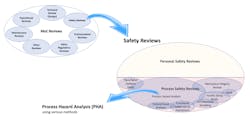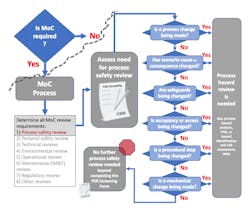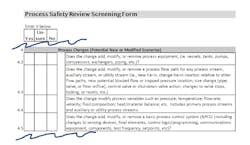Process Safety: Avoid Big Trouble from Little Changes, Part 1
Just as Management of Change (MoC) is an essential element of any process safety management (PSM) program, the process-hazard review that occurs under MoC is an essential element of an effective MoC process. But what is the best way to determine the process-hazard review needs for small changes? And how do you ensure that reviews are adequate and not missed?
Clarify The Terminology
Terminology for process-hazard reviews varies from region to region and between regulating authorities. As shown in Figure 1, safety reviews are one of many reviews performed under MoC [1]. Safety reviews include both personal safety and process-safety reviews.
Process-safety reviews can be subdivided into process hazard analyses (PHAs), facility siting studies, flare studies, major accident risk (MAR) studies, functional safety reviews (such as using ISA 84 or ISO 61511 standards), consequence modeling and others. PHAs may be further subdivided by the methods used for conducting the studies, which may include hazard and operability (HAZOP) studies, layers of protection analysis (LOPA), checklists and others [2]. Hazard identification and risk analysis (HIRA) [3], also known as hazard identification and risk assessment [4], is another term used to describe the same suite of process hazard analysis methods. (Note, the terms PHA, HIRA, process hazard assessment and process hazard review may be used interchangeably and refer to the same practices.)Process Safety Review Screening
How do we determine the applicable process-safety reviews for a given change or MoC? Screening the change for review requirements is the first step.
Effective screening is needed not only to define process-hazard review requirements but also to assess all reviews for applicability under a given MoC [1]. However, the need for certain reviews may be more apparent than others. Introducing a change that has the potential for process-safety impacts may not be intuitively obvious; therefore, a structured and objective screening process can help ensure consistency. A checklist specifically designed to highlight modifications that result in process changes or changes to equipment can support the determination of further process safety review needs.
Screening Form Categories
When creating a process safety review screening form, consider the following types of changes. Changes in these categories will prompt the need for process safety review(s).
• Process changes
• Mechanical changes
• Changes to safeguards
• Changes to scenario causes
• Changes to consequences (including changes to consequence assessment based on other work, studies or guidance)
• Changes to occupancy or access
• Changes to operational procedural steps
• Other
The flow chart in Figure 2 shows an overview of a decision process for determining whether process-hazard reviews are required.Process-safety incidents typically involve loss of containment of process media. Containment is directly dependent on both the properties of the process media being contained and on the equipment containing the process. Because of this relationship, the mechanical properties of the equipment are referenced directly in many areas of the process-hazard review. Mechanical design also undergoes discipline-specific technical review, as well as maintenance consideration outside of the process hazard review.
Improper design stemming from other disciplines, such as civil and structural, could potentially lead to process-safety hazards and to the release of process media. However, the methodologies used for conducting process-hazard reviews will generally not support the identification of hazards associated with these design failures. Any past or known operational or design issues that may lead to process hazards, such as structural failure due to vessel or tower overfill (if not designed for a fluid-filled column), need to be included in appropriate hazard scenarios. Operating limits and safe limits need to align with design assumptions. Technical reviews and checklists associated with various disciplines should be updated to address design weaknesses, incorporate new learnings, and, where possible, integrate inherently safer design. However, mechanical changes to piping, static equipment and rotating equipment are highlighted as triggering a process-hazard review because of the direct impact on hazard scenarios throughout the study.
Screening Form Questions
Figure 2 shows an overview of categories needing consideration. To ensure thorough and consistent screening, include specific questions in each section of the screening form. Some practitioners may believe more detailed questions are unnecessary or overly time-consuming to answer. However, past auditing of process-safety-review screening failures under MoC shows even competent engineers miss relevant changes if only general questions are asked. These misses result in incomplete or fully bypassed process-hazard reviews. More detailed and specific questions better ensure consideration of pertinent factors that improve consistency and prevent human errors.
For identifying changes to the process, questions such as in Figure 3 could be included.
The questions are examples and do not represent a complete list of changes that would indicate a process change has occurred. Other sections of the form also need to include specific screening questions. These questions should be routinely reviewed and refreshed through continuous-improvement efforts.
In some cases, prescribed questions are too limiting or may be incomplete. To address this, “other” may be used as a catch-all for open-ended brainstorming.
Who Completes and Approves?
MoCs are ubiquitous in modern processing and manufacturing operations. Companies address MoCs constantly of all scopes and sizes. Because operating companies handle so many MoCs, their protocol may allow personnel in a variety of roles to initiate or manage the change through its lifecycle. However, to ensure proper design, assessment and implementation of the change, specialists from all impacted disciplines need to be engaged in evaluating the change [1]. This need is especially true for process-hazard assessment. Even where questions are carefully crafted to identify conditions needing process-safety assessment, without a skilled process-safety practitioner signing off on the screening, changes can be missed that should receive process-hazard review. Auditing has shown these types of errors are routinely introduced when qualified process-safety personnel are not involved. These misses indicate that providing process safety-related training to personnel filling other roles is not sufficient.
For this reason, ensure the process-safety screening is approved only by qualified, skilled personnel representing the process-safety department or group. Other personnel may initiate or fill out the form, but final review and approval should be conducted by skilled process safety professionals.
Case in point: While conducting an MoC audit on a company’s process-safety-review screening step, several errors were discovered on completed screening forms. Certain process changes were missed including a modification involving a pipe-size change. Pipe-size changes may result in various integrity-related concerns, including erosion from higher velocities, corrosion stemming from particulate settling caused by lower velocities, or pump damage due to cavitation resulting from improperly installed upstream reducers. The screening form had been completed by a well-qualified plant engineer who had received training on MoC and general process safety principles.
Several changes were made to the screening process following this audit to prevent similar errors in the future. Changes were made to the form criteria, including stipulating velocity changes as a type of process parameter change and naming size change as a type of equipment change that defines a process change. To further support the process, administrative changes were made requiring process-safety representative review and approval of all completed screening forms.
When Should Screening Happen?
As the title implies, the MoC process-safety review is inherently one of the most critical reviews under process-safety management. Therefore, process safety review screening — at a minimum — is needed for all MoCs.
If the change is screened and no items on the checklist trigger the need for process-safety reviews of any type, including process hazard review, then the completed process safety review screening form along with a statement supporting the decision to not conduct further process safety reviews can become the record of the assessment (Figure 2). In general, changes that fall into this bucket should be less common than changes needing further process-safety review.
In addition to MoCs, any practices that may handle changes through alternative protocol outside of the MoC system should use the same screening process and tools. Construction change orders are one example. Construction groups may handle many changes during a project. However, any change triggering criteria from the process-safety-review screening form represents a change to the approved design as reviewed during the project PHA. Changes introduced through construction change orders may bypass process-hazard review if consistent tools and approval processes are not used. Supplementing construction change management practices by using the same process-safety-review screening form with process-safety representative sign-off can prevent those misses.
What Not to Do — Inappropriate Screening Questions
Avoid asking questions during the screening process that presuppose the outcome of the hazard review. Examples of questions that should not be included on screening forms include:
• Does the change introduce new process safety hazards?
• Does the change elevate process safety risk?
• Does the change have the potential to be hazardous or highly hazardous?
• Does the change involve hazardous operations or processes?*
* When MoC is required, safety reviews, are applicable. Where companies have elected to apply MoC more broadly than required by regulation, exclusions need to be clearly defined in procedures.
Opinion, judgment or perceived risk assessment should not be part of the screening process. The purpose of the process-hazard review is to identify process-safety hazards that would not otherwise be apparent. Process-hazard reviews use a structured method to help team members see hazards that a cursory assessment would not uncover. Screening questions should categorize the change into types of changes that require process-hazard review. Injecting opinion into the screening process short-circuits the hazard review.
Auditing
Auditing of the full MoC and hazard-review process under MoC, including this screening step, is a key part of maintaining an effective program. Internal or self-auditing support continuous-improvement efforts. Routinely audit the usage of the screening form to ensure the checklist is being used as intended.
Validate that the change has been correctly characterized on the screening form based on the criteria given and ensure the proper personnel review and sign off. If misses or errors are found, seek to understand the origin of the failures through standard root-cause analysis. Follow-up with edits or revisions to the tools and process, as needed.
Conclusion
Why devote so much effort to a seemingly straightforward task? The reasons are simple. First, if the need for process-safety review is not identified, the process-safety reviews including the process-hazard assessment by any method will not occur. Concerns regarding the quality and selection of the review method are immaterial if the process-hazard review has been inadvertently or intentionally bypassed. Secondly, failures occurring at the screening step are not uncommon. Careful auditing may demonstrate that problems related to conducting effective process-safety reviews on MoCs may originate at the screening stage.
Better practice involves applying the process-safety review screening form and process to every change no matter how small. Changes to the process being contained, the equipment containing the process, the equipment involved in protecting the process, and operating procedures all need complete process-hazard review. To aid in a thorough initial assessment and to help avoid misses, include specific, detailed questions under all categories of the process-safety review screening form and involve skilled process-safety practitioners as approvers of the screening.
Part two of this series will address the selection of the type of process hazard review method for small changes.
References
1. Olsen JE, “Management of Change Reviews for Small Modifications,” pp. 35-38, Chemical Engineering Progress, American Institute of Chemical Engineers, December 2022.
2. U.S. Department of Labor Occupational Safety and Health Administration, Process safety management of highly hazardous chemicals, 29 CFR §1910.119 ( e) and (l), Jun 1, 1992.
3. CCPS, Guidelines for Risk Based Process Safety, Center for Chemical Process Safety, American Institute of Chemical Engineers, New York, NY, 2011.
4. U.K. Health and Safety Executive, “The Control of Major Accident Hazards Regulations 2015,” L111 (Third edition), 2015.
About the Author
Jody E. Olsen
Principal engineer and Manager at JE Olsen Consulting LLC
Jody E. Olsen, P.E., is the principal engineer and manager at JE Olsen Consulting LLC. She provides process safety consulting services in process hazard analysis (PHA), management of change (MoC), pre-startup safety review (PSSR), root cause failure analysis, mechanical integrity, and other process safety management (PSM) elements. Prior to this role, she spent nearly three decades working in upstream oil and gas production for Mobil Oil, Aera Energy, and BP.




